

{Shikoku Hachijūhachikasho Meguri}
--OVERVIEW--


--OVERVIEW--
 |
 |
Summary: This is a Buddhist pilgrimage around the circumference of the Japanese island of Shikoku. Of the several hundred thousand people who do it each year, only a few thousand walk; the vast majority travel in organized bus tours. If you only walk to the main 88 temples, the trail is about 1,100 km (~670 mi). If you also walk to the 20 bekkaku temples (of secondary importance, but still visited by some), the distance increases to about 1,400 km (~860 mi). Visiting all 108 temples takes about 50–55 days. Visiting only the main 88 temples takes about 40–45 days. How long it takes for each henro (pilgrim) depends on their fitness level and their seeming need to hurry.
Staring vacuously into space, the woman was kneeling on the floor at the door to the Daishdō, chanting a mantra over and over again. She was chanting as if her life depended on it, and for all i knew she may have truely believed that it did. As other henro (pilgrims) came up the steps, in groups and individually, to recite their sutras and prayers, the woman seemed oblivious to them — totally absorbed in a world only she could see and only she inhabited.
Was she pleading with Kōbō Daishi for something? For someone's improved health? For a child's success at school? For someone's success in business? For a lost spouse's safe journey to paradise? Or was she thanking him for some actual or perceived gift? I never knew at the time, and most likely no one except her did either. But, she was, without doubt, talking directly, face-to-face, with the Daishi, and all of the other henro simply took her for granted. They stood next to her, behind her, over her, and around her, but they never disturbed her or gave the slightest impression that she was in the way.
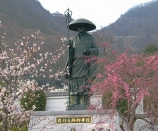 Kōbō Daishi, to this day, still evokes an incredible level of respect and awe in Japan. It is still, in the 21st century, considered perfectly acceptable to have a conversation with a Buddhist monk that died in the early 9th century. But, while he is known throughout the country, the focus of hommage to him is located on the island of his birth — Shikoku.
Kōbō Daishi, to this day, still evokes an incredible level of respect and awe in Japan. It is still, in the 21st century, considered perfectly acceptable to have a conversation with a Buddhist monk that died in the early 9th century. But, while he is known throughout the country, the focus of hommage to him is located on the island of his birth — Shikoku.
Kōbō Daishi is, arguably, one of the most famous Japanese to have ever lived. Born in 774, he was a priest, poet, scholar, educator, advisor to the emperor, administrator, and master calligrapher. He traveled to the Chinese capital of Ch'ang-an to study esoteric Buddhism, founded the Japanese sect of Shingon Buddhism upon his return to Japan, founded a monastic center on Mount Kōya, founded the first public school open to commoners as well as aristocrats, is considered by many to be one of the three best calligraphers in all of history, and is attributed (incorrectly) with inventing the Japanese kana syllabary. He is a cultural icon and hero, and known by virtually every Japanese. Whether they believe in his miraculous powers or not, everyone knows who he is and what he means to a lot of people.
Born on the island of Shikoku to the aristocratic Saeki family, it was expected that he would attend the university and take his rightful place in the court of the emperor. At age fourteen he made the trip to Nagaoka (the capital city for a short time between Nara and Kyōto) and began studying under the tutelage of his maternal uncle. At eighteen he enrolled in the university — but within a year his new and growing interest in Buddhism and his search for 'Truth' led him to give up everything, leave the capital, and return to the mountains of Shikoku. Against the wishes of his family he became a wandering mountain ascetic and unordained monk, eventually taking the name Kūkai. The rest of the story, as they say, is history.
Posthumously given the title Kōbō Daishi, he was long ago elevated to the status of sainthood and is revered by both Buddhists and non-Buddhists alike. Without doubt, the most important pilgrimage in Japan (and there are many) is this trip to each of the 88 temples attributed to him on the island of Shikoku. If done in the traditional manner, it entails walking 1,100 km around the circumference of the island and usually takes between 40 and 50 days to complete. If you also visit 20 additional temples also affiliated, but lesser so, with the pilgrimage you cover 1,400km and it takes 50–60 days. The pilgrimage is almost always walked in a clockwise direction and each of the temples is visited in turn.
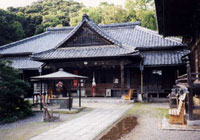 For those used to the grand and glorious temples found in Kyōto, Nara, and Kamakura, these temples stand out for their simplicity. The difference is striking. None of the temples found on this pilgrimage would be considered ornate or elegant. None of the temples have elaborate gardens and the buildings themselves are not as beautiful or as well maintained as their more famous cousins — but they were never intended to be. They were not built to serve the same purpose. The more famous temples were built for, by, and to serve the aristocrats and warriors. Those on Shikoku were built (for the most part) for, by, and to serve the common person. The fisherman. The carpenter. The housewife. The student. The merchant. The out of work beggar. The difference shows dramatically, but for that reason something about them resonates as being more alive, more approachable, more meaningful. By the end of the trip it is clear that it is the pilgrimage itself that makes them special.
For those used to the grand and glorious temples found in Kyōto, Nara, and Kamakura, these temples stand out for their simplicity. The difference is striking. None of the temples found on this pilgrimage would be considered ornate or elegant. None of the temples have elaborate gardens and the buildings themselves are not as beautiful or as well maintained as their more famous cousins — but they were never intended to be. They were not built to serve the same purpose. The more famous temples were built for, by, and to serve the aristocrats and warriors. Those on Shikoku were built (for the most part) for, by, and to serve the common person. The fisherman. The carpenter. The housewife. The student. The merchant. The out of work beggar. The difference shows dramatically, but for that reason something about them resonates as being more alive, more approachable, more meaningful. By the end of the trip it is clear that it is the pilgrimage itself that makes them special.
There are 88 temples that are considered the main pilgrimage temples. There are as many arguments as to why these 88 were chosen for inclusion as there are people debating the issue. In addition, there are hundreds of other temples that associate themselves with the pilgrimage. Being outside of the one to eight-eight numbering system they are called bangai (outside the numbers) temples. Of these several hundred, 20 have somehow managed to earn the reputation of being considered the 20 most important, and are known as the 20 bekkaku temples. For this reason, some people believe that a pilgrim earns extra merit by including these 20 temples in his/her walk around the island. Especially since visiting the main 88 plus the 20 bangai temples totals 108 — a very important number in the world of Buddhism.
The temples are spread around the circumference of the island. In some areas, especially in and around the larger cities, the temples are located close together and you visit numerous temples in one day. In other areas the temples are more spread out and it can take three days to walk from one to the next. Of the eighty-eight main temples, sixty-one are located in the mountains and twenty-seven are on the plain near the coast. Of the sixty-one temples located in the mountains, twenty-five are located at or near the top of their mountain with the highest situated at an elevation over 900 meters.
Of course, not all of the temples, statues, fresh water springs and wells, etc. that are attributed to Kōbō Daishi were actually built by him. Much of the historical evidence proves otherwise. Likewise many of the legendary deeds attributed to him were, in fact, performed by other people. But what is known with certainty is that Kōbō Daishi was born here, returned here after leaving the university, walked many of these trails, visited several of these temples, and spent many years of his life on this island. His spirit is still here and those who open themselves to it will feel his presence while they walk. As the motto for the pilgrimage says, "Dōgyō Ninin" (We Two, Traveling Together)
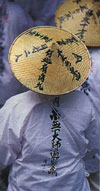 Oliver Statler says it well in his book Japanese Pilgrimage:
Oliver Statler says it well in his book Japanese Pilgrimage:
"...this pilgrimage has no goal in the usual sense, no holy of holies to which one journeys and, after celebration in worship, returns home. This pilgrimage is essentially a circle: a circle has no beginning and no end. And so it is not at all important where one begins. What is important is that one go all the way around and return to one's starting point. One must close the circle.'...what is important is not the destination but the act of getting there, not the goal, but the going. 'The Path is the goal itself.'
'...They say a pilgrim carries the baggage of his life: true, and the pilgrimage gives him time to sort out some of it.
'...if you are earnest, you will to some degree be transformed."
Or as Swami Chinmayananda says about this type of transformation:
"Pilgrimage is a very powerful means of self-purification, for if the pilgrim has eyes and ears to watch and experience the beauty and majesty of nature, then his capacity to contemplate explodes within himself and he reaches hitherto unknown depths."
Shikoku is the smallest of the four main islands in the Japanese group and lies nestled in the Seto Inland Sea off the southern coast of the main island of Honshū. It is divided into the four provinces of Ehime, Kagawa, Kōchi, and Tokushima, and remains, even today, as one of the most rural areas of Japan. While there are, without question, long stretches of the trail that simply follow major highways and offer little scenery of interest, the island is mountainous and its beauty can be both stunning and breathtaking. Walking through the mountains in the first weeks of the pilgrimage is like walking through an abstract painting overflowing with greens of every hue and shade: bright reds, burgundy reds, oranges that almost reflect off the clouds, and yellows that are so bright as to hurt the eyes when you look at them. And then, as if those colors aren't enough, here and there, rising just above the canopy of those colors, are explosions of pink coming from the mountain cherry blossom tree — exploding above all the other colors like those fireworks that burst high in the sky in hugh spheres and then rain down in long cascades of dazzling colors.
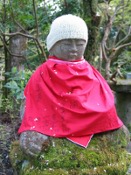 Before you get there, however, the trip traditionally starts with a visit to Kōbō Daishi's mausoleum at the monastery he founded on Mount Kōya in Wakayama Prefecture on the main island of Honshū. Located behind the Okunoin at the far end of the most famous cemetary in all of Japan, the mausoleum is rather nondescript. For true believers, Kōbō Daishi is still alive, sitting in meditation until the return of the next buddha. It is here, in front of his mausoleum, that you ask for his blessing, guidance, and help, or even that he accompany you around the island. Whatever you ask, from here you descend the mountain and take a boat, train, or bus to Shikoku, landing in the town of Tokushima on the eastern side of the island. From there, the island is walked in a clockwise direction visiting each temple in turn, starting in Tokushima Prefecture and continuing through Kōchi Prefecture, Ehime Prefecture, and Kagawa Prefecture before finally returning to Temple One where it all began.
Before you get there, however, the trip traditionally starts with a visit to Kōbō Daishi's mausoleum at the monastery he founded on Mount Kōya in Wakayama Prefecture on the main island of Honshū. Located behind the Okunoin at the far end of the most famous cemetary in all of Japan, the mausoleum is rather nondescript. For true believers, Kōbō Daishi is still alive, sitting in meditation until the return of the next buddha. It is here, in front of his mausoleum, that you ask for his blessing, guidance, and help, or even that he accompany you around the island. Whatever you ask, from here you descend the mountain and take a boat, train, or bus to Shikoku, landing in the town of Tokushima on the eastern side of the island. From there, the island is walked in a clockwise direction visiting each temple in turn, starting in Tokushima Prefecture and continuing through Kōchi Prefecture, Ehime Prefecture, and Kagawa Prefecture before finally returning to Temple One where it all began.
Another, more traditional and religious, way to look at the trip around the island is to keep in mind that walking through the four prefectures is equivalent to progressing through four spiritual stages. You start your journey in the Dōjō of Awakening Faith (Hosshin no Dōjō) where you awaken the faith that will be required for later spiritual progress. You next pass into the Dōjō of Religious Discipline (Shūgyō no Dōjō) where you begin the process of submitting yourself to strict religious discipline.
The third step of the process (and the third prefecture) is the Dōjō of Awakening (Bodai no Dōjō) where, after much effort, the path becomes clear. Finally you pass into the Dōjō of Nirvana (Nehan no Dōjō) where your need to follow the path comes to an end. From here you return to Temple 1 to offer thanks and then go back to everyday life, but by now you have figured out how to live.
As the map of Shikoku below shows, with the exception of occasional excursions inland, the walk generally follows the coast around the island. The henro trail is drawn in red and numbers correspond to each of the 88 temples. I didn't include the 20 bangai temples in this map
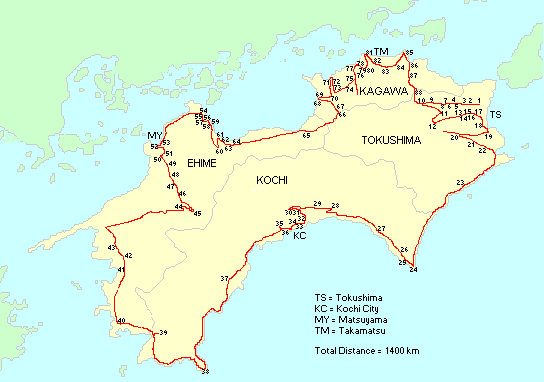
I have walked the pilgrimage in its entirety four times, the first in 1999 and the latest in 2016. These pages are a result of those trips. They are an attempt to make available all of the information that i wish i had had before i set out on that 1999 trip, when i knew nothing and didn't know anyone else who did either. It includes the history of the pilgrimage and of the major historical personages. It also includes information that can be used for planning your own pilgrimage. If you would like to talk to people that have actually walked the pilgrimage, i have included a list of "Known Henro" that have agreed to answer questions. Feel free to contact them.
In addition you will find links to other web sites that have more information available. If you can read Japanese there is an almost unlimited amount of information available on the web, but i have not included those links here. You can get to them, though, through the few Japanese links that i do provide. These pages are an attempt to fill in the gap for non-Japanse speakers. For those who want to do more research, i have also included a bibliography of all the English language sources that i have used to prepare this site.
Lastly, i have also included the daily journal i kept while on the henro (pilgrimage) trail, my schedule, a list of the places i stayed, and an all inclusive breakdown of what it cost me to do the walk.
If you see ways to improve this site, would like to contribute something of your own (your journal, any special information, ... anything you want), or would just like to make a comment, please don't hesitate to get in touch with me. (Contact Information).
